Droop Mountain Battlefield State Park
Introduction
Text-to-speech Audio
Images
A West Virginia roadside historical marker gives a brief synopsis of the battle.
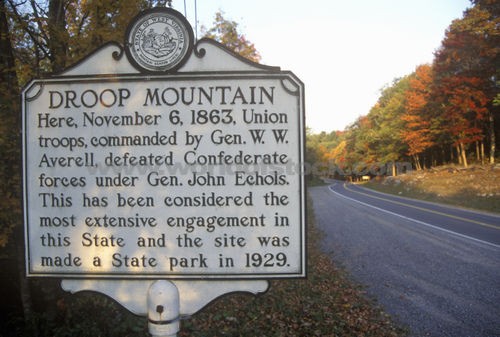
Recent years have brought new memorials, trails, and interpretive markers to Droop Mountain.
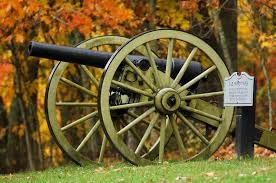
A map of the battle showing the envelopment of Echols by Averell's forces. The Confederate defensive position was strong, but Averell's numbers allowed him to overwhelm the Rebel works.
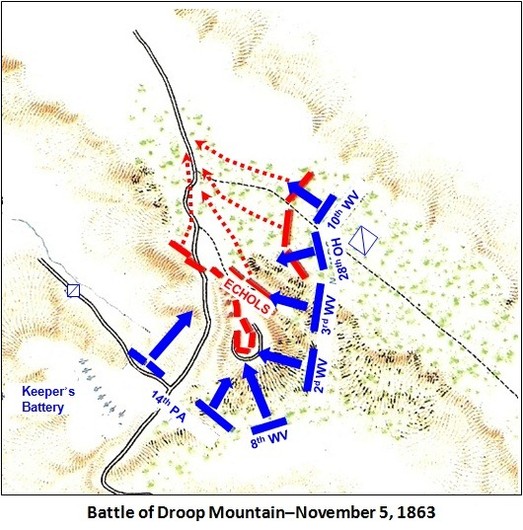
Union Brigadier William Woods Averell. A career soldier, he spent nearly two years on crutches before the Civil War began as a result of a leg wound suffered in fights with the Navajo in the 1850s.
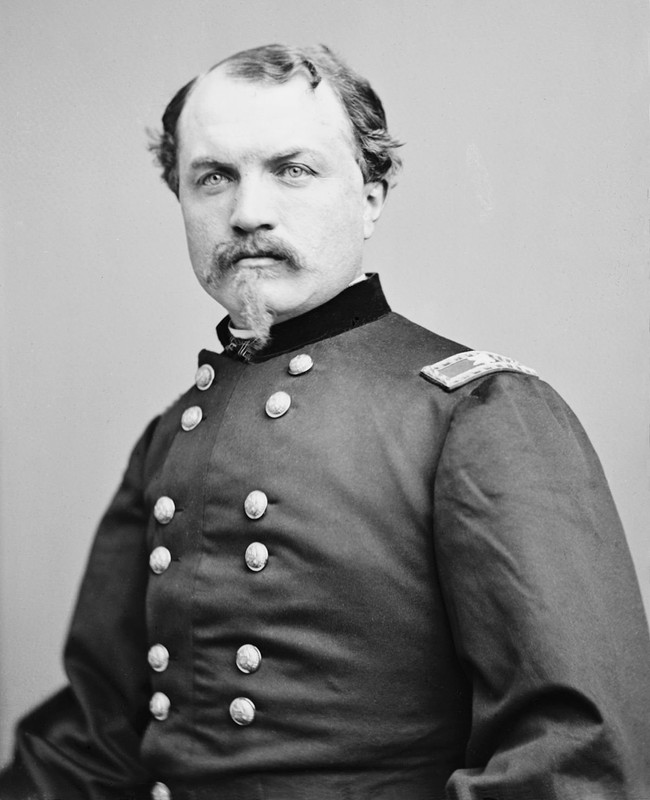
Confederate Brigadier General John Echols handled his men ably throughout the battle and during the difficult retreat from Droop. After the war he became a successful businessman.
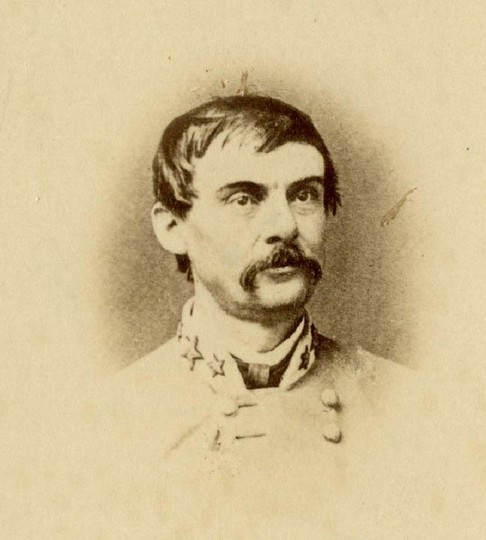
A postwar portrait of Col. J.M. Schoonmaker, commanding officer of the 14th Pennsylvania Cavalry. Schoonmaker played a prominent role in several of Averell's raids, and later was awarded the Medal of Honor for actions at the Battle of Winchester.
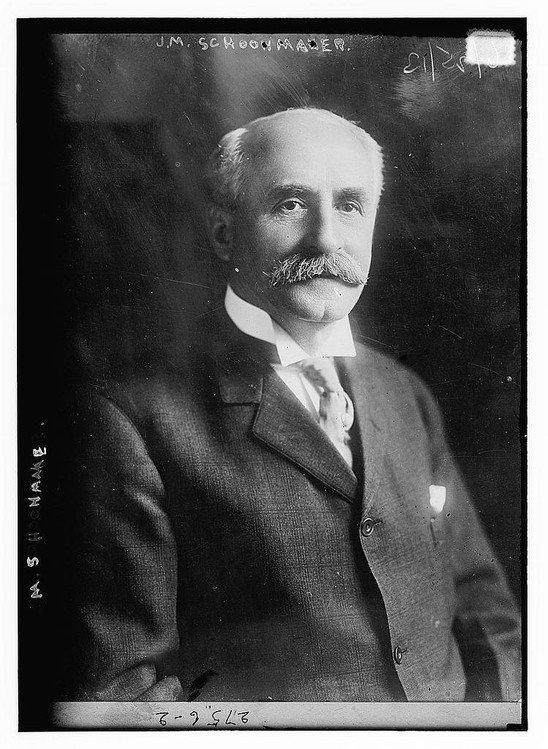
Colonel William L. "Mudwall" Jackson often found himself at the unfortunate end of Averell's raids. Despite evidence that he was a competent commander, he never lived up to the reputation of his famous cousin, "Stonewall" Jackson.
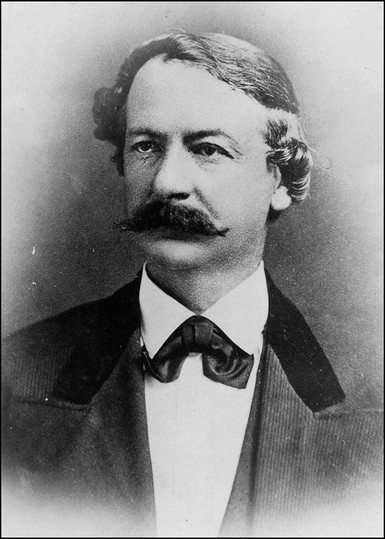
A larger overview of the battle using modern satellite imagery, showing Averell's approach, flanking movement, and the Confederate retreat.
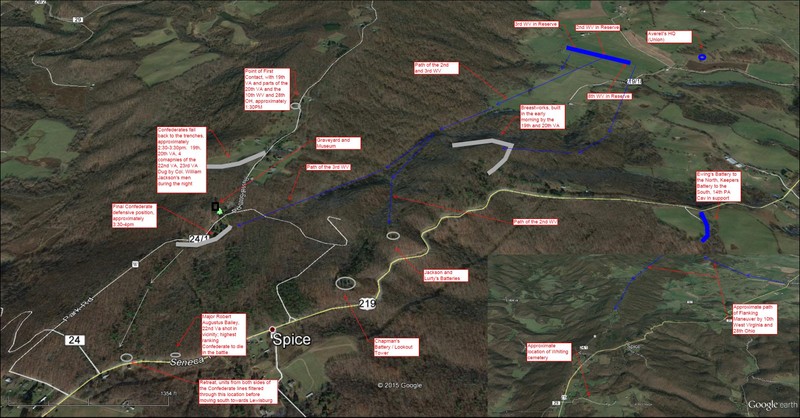
The view from Droop Mountain's Lookout Tower, designed to afford breathtaking views not only of the valley, but of the approach of the 14th Pennsylvania and the position of Averell's artillery.
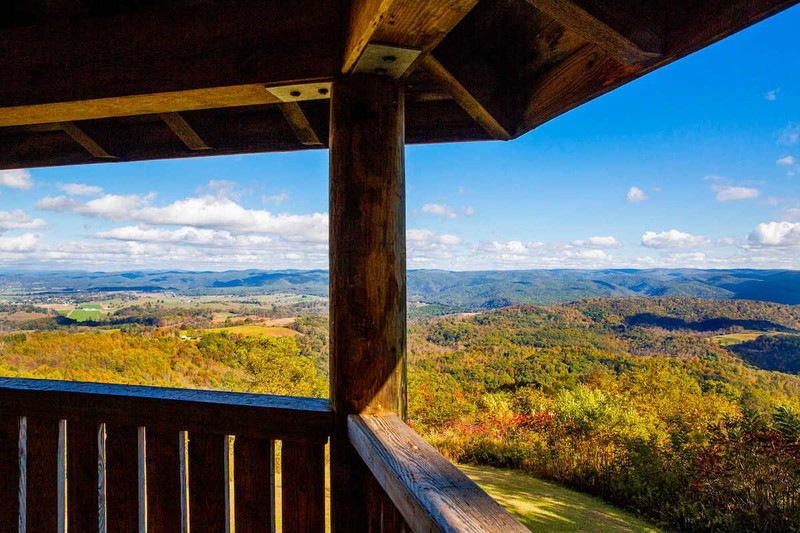
Interpretive signs throughout the park bring the battle to life.
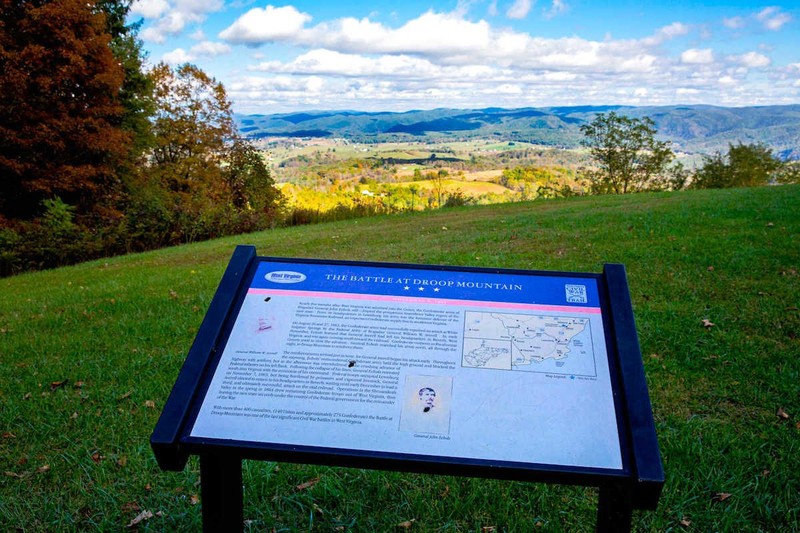
Droop's Lookout Tower was built in the 1930s by the New Deal-era Civilian Conservation Corps.The CCC's activities were the first major updates to West Virginia's first State Park.
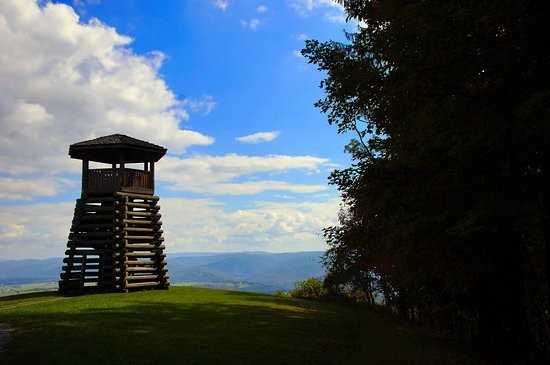
Civil War historian Terry Lowry's book is the only book-length investigation of the battle.
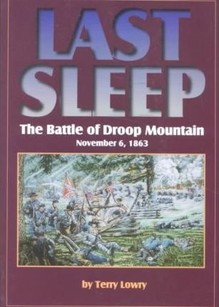
Historian Eric J. Wittenberg's book on the Battle of White Sulphur Springs details the events of Averell's first raid, two months before Droop Mountain.
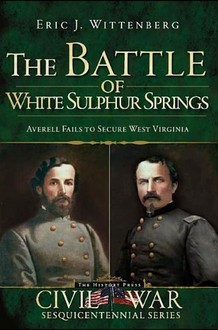
Backstory and Context
Text-to-speech Audio
Following the Union defeat at Chancellorsville, Union Brigadier General William Woods Averell was transferred to West Virginia and put in charge of the Fourth Separate Brigade in May 1863. While the assignment was most likely intended as a punishment by General Joseph Hooker for the failure at Chancellorsville, as Hooker used Averell as one of the scapegoats, Averell transformed the West Virginia, Pennsylvania, and Ohio troops he commanded into a well-drilled outfit. Following the Battle of White Sulphur Springs on August 26-27, 1863 against Colonel George S. Patton, a grandfather of the World War II general, and his confederate troops, Averell withdrew his troops of 1,300 the following morning and evaded several Confederate ambushes back to Beverly. Averell and his men had failed to capture Lewisburg. Averell learned from this battle and two months later, he and his increased troops, 3,800 cavalry and infantry supported by two artillery batteries, traveled south to cut the railroad from Beverly on November 1st. In addition to his own increased troops, Averell was set to meet up with General Alfred Duffie in Lewisburg on November 7th as his 2,500 Federal troops as they traveled from Charleston.
Contact was made between Averell’s troops and Confederate forces on November 4th halfway to Lewisburg at Huntersville. These Confederate troops were the 19th Virginia Cavalry commanded by Colonel William “Bill” Lowther “Mudwall” Jackson, a cousin the late Lieutenant General Thomas J. “Stonewall” Jackson. Jackson alerted Confederate commander Brigadier John Echols in Lewisburg. Echols quickly prepared to come to Jackson’s aid. Averell began pushing Jackson’s skirmishers back at a leisurely pace so not to outpace Duffie to Lewisburg. Jackson broke contact with Averell on November 5th and retreated to the formidable height of the flat top of Droop Mountain. Averell would need to secure the mountain before moving south. With limited troops, Jackson could not hold out for long. Fortunately for him, that night Echols finally decided to join him and his 1,110 troops set out at 2 a.m. on November 6th. Echols had held back out of concerns that he and his men would be caught in a pincer movement by Averell and Duffie.
Averell’s plan was put into motion at dawn on November 6th. Averell’s victory would be a nearly flawless textbook victory, a rarity of Civil War battles. Upon receiving reports from scouts that Jackson and Echols were positioned at the top of Droop Mountain, Averell knew that a frontal attack would bring heavily casualties. Averell split the 28th Ohio and 10th W.Va. onto the southwest Lobelia Roach toward the Confederate left flank. Averell’s’ artillery were to cause a distraction on the main approach and thus convince Echols that the main attack would come from there, the Hillsboro Road. Echols ignored warnings from troops stationed on the flank of the dangers of leaving Lobelia Road. Averell’s lieutenants, who held synchronized watches over the difficult terrain, pulled off a perfectly coordinated attack. Around 2 p.m. Colonel Agustus Moor and his 28th Ohio Infantry crashed into the Confederate’s extreme left. Then the 3rd, 2nd, and 8th W.Va regiments, who had crept up the steep slopes and through the brush, began their attack when Moor’s men began firing. Their combined attack quickly left the Confederate left flank buckling. Echols was forced to pull troops from his center and right to even it up. Averell’s distraction on Hillsboro Road had been a success.
With the movement of Echols’ troops to deal with the left flank, Colonel J.M. Schoonmaker and his Pennsylvanian troops rushed Echols’ now weakened center. Echols was outnumbered during the fierce fighting in the dense brush and Averell’s maneuver deprived the Confederates of Droop Mountain’s natural advantages. After two hours of frenetic struggle, the Confederate line broke and the troops fled. With a rearguard protecting the fleeing Confederates from the pursing Union troops, Echols managed to keep his command from disintegrating over the trek back to Lewisburg. Both sides suffered high casualties with Union losing 119 soldiers to the Confederate’s 275 soldiers. Echols and his men fled Lewisburg the following day. Interestingly, the pincer movement that Echols had feared from the Union troops never materialized as Duffie stopped seven miles from Lewisburg on November 6th. Averell arrived at Lewisburg on November 7th, as planned. The following day, he was incorrectly informed that Confederate troops were beginning to mass against him. Averell moved his troops to White Sulphur Springs and began to march northward to Beverly. Due to scare supplies, prisoners and captured livestock, and perhaps a career consideration, prevented Averell from continuing onto Salem to destroy the Virginia & Tennessee Railroad. While this second attempt was a failure, Averell would lead a successful third attempt the following month.
Noted Civil War historian Terry Lowry has disputed the long-held claim that Averell’s victory at Droop swept the last Confederate resistance from the state, pointing out larger conditions in the theater of war that may have prevented the Confederate government from investing more time and effort into reclaiming West Virginia. Nevertheless, Rebel troops did not return to the area in force for the duration of the war. Lowry also disputed the claim that the battle of Droop Mountain was the most significant Civil War battle in West Virginia, claiming that the 1862 capture and siege of Harpers Ferry was. However, Lowry did agree that the Battle of Droop Mountain was one of the more important Civil War battles in West Virginia.
On July 4, 1928, the site of the Battle of Droop Mountain was dedicated as West Virginia’s first state park. Many of the battle’s living survivors were present at the dedication, along with about 10,000 spectators. Over 1,000 automobiles were also present. While the 125-acre park was popular, very little construction was done until 1935 when a Civilian Conservation Corps group was camping at the park and constructed several monuments that are still in use today. Recent scholarship and preservation efforts have allowed for a museum to operate in the park and for new markers to be erected. Today the park is also home to several recreational facilities such as playgrounds, hiking trails, picnic areas, and even a lookout tower that provides a wondrous view of the surrounding area. The park is also part of The Civil War Discovery Tail. Reenactments of the battle are held every other year.
Sources
1. Interview / email exchange with Michael Smith, Superintendent of Droop Mountain State Park
2. Droop Mountain. National Park Service. . Accessed July 04, 2018. http://www.nps.gov/hps/abpp/battles/wv012.htm.
3. Cook, Roy Bird. The Battle of Droop Mountain. West Virginia Archives & History. . Accessed July 04, 2018. http://www.wvculture.org/history/civilwar/droopmountain01.html. Originally published in the West Virginia Review, October 1928.
4. Eric J. Wittenberg, The Battle of White Sulphur Springs, Charleston SC, The History Press, 2011. p.93.
5. Sutton, J.J.. History of the Second Regiment, West Virginia Cavalry. San Bernardino, CA. Old South Books, 2016. Originally published 1892.
6. Lowry, Terry. Last Sleep: The Battle of Droop Mountain. Charleston, West Virginia. Pictorial Histories Publishing Co., Inc., 1996.
7. Bard, David. The Civil War in the New River Valley. Charleston, WV. Quarrier Press, 2004. p. 69-80
8. Casto, James E. The Battle of Droop Mountain. Wonderful West Virginia. August 1st 2013. 4 - 7.
9.Droop Mountain Battlefield, Pocahontas County WV. Accessed March 9th 2020. https://www.pocahontascountywv.com/droop-mountain-battlefield.
